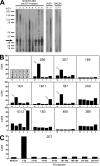A novel myelin P0-specific T cell receptor transgenic mouse develops a fulminant autoimmune peripheral neuropathy
- PMID: 19221395
- PMCID: PMC2699118
- DOI: 10.1084/jem.20082113
A novel myelin P0-specific T cell receptor transgenic mouse develops a fulminant autoimmune peripheral neuropathy
Abstract
Autoimmune-prone nonobese diabetic mice deficient for B7-2 spontaneously develop an autoimmune peripheral neuropathy mediated by inflammatory CD4(+) T cells that is reminiscent of Guillain-Barré syndrome and chronic inflammatory demyelinating polyneuropathy. To determine the etiology of this disease, CD4(+) T cell hybridomas were generated from inflamed tissue-derived CD4(+) T cells. A majority of T cell hybridomas were specific for myelin protein 0 (P0), which was the principal target of autoantibody responses targeting nerve proteins. To determine whether P0-specific T cell responses were sufficient to mediate disease, we generated a novel myelin P0-specific T cell receptor transgenic (POT) mouse. POT T cells were not tolerized or deleted during thymic development and proliferated in response to P0 in vitro. Importantly, when bred onto a recombination activating gene knockout background, POT mice developed a fulminant form of peripheral neuropathy that affected all mice by weaning age and led to their premature death by 3-5 wk of age. This abrupt disease was associated with the production of interferon gamma by P0-specific T cells and a lack of CD4(+) Foxp3(+) regulatory T cells. Collectively, our data suggest that myelin P0 is a major autoantigen in autoimmune peripheral neuropathy.
Figures





References
-
- Kieseier B.C., Kiefer R., Gold R., Hemmer B., Willison H.J., Hartung H.P. 2004. Advances in understanding and treatment of immune-mediated disorders of the peripheral nervous system.Muscle Nerve. 30:131–156 - PubMed
-
- Miller S.D., Turley D.M., Podojil J.R. 2007. Antigen-specific tolerance strategies for the prevention and treatment of autoimmune disease.Nat. Rev. Immunol. 7:665–677 - PubMed
-
- Bour-Jordan H., Thompson H.L., Bluestone J.A. 2005. Distinct effector mechanisms in the development of autoimmune neuropathy versus diabetes in nonobese diabetic mice.J. Immunol. 175:5649–5655 - PubMed
Publication types
MeSH terms
Substances
Grants and funding
LinkOut - more resources
Full Text Sources
Other Literature Sources
Medical
Molecular Biology Databases
Research Materials

